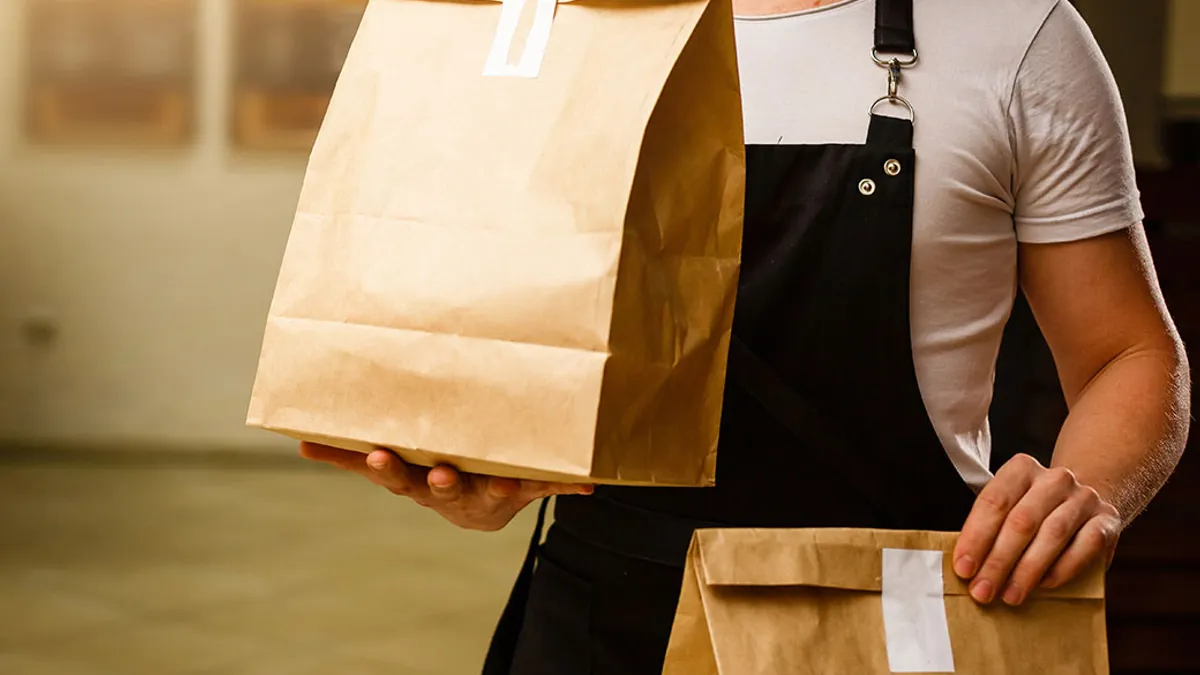Increased interest in restaurant delivery during the COVID-19 pandemic breathed new life into the ghost kitchen concept, helping the industry’s revenue swell to roughly $2.6 billion this year in the U.S.
By 2022, nearly 44,000 restaurants were operating under a ghost kitchen business model—which can include renting culinary space in a large facility or utilizing part of a functioning restaurant’s kitchen to prepare a separate menu for an eatery that doesn’t have an actual physical location.
With continued strong demand for off-premise dining, ghost kitchens are expected to comprise 50% of the drive-thru and takeout market globally by 2030, presenting a unique growth opportunity for operators.
Ghost kitchens’ multifaceted appeal
Ghost kitchens offer a variety of benefits to restaurant operators:
Deliver orders
Eateries that weren’t initially designed to accommodate the increased interest in delivery orders—potentially some of the 80% of fine dining establishments that added the service during the pandemic and plan to continue offering it—may benefit from moving deliveries off-site to free up space in their kitchen.
The Five Guys burger chain, for example, told Insider it rerouted London delivery orders to a ghost kitchen because the sizable volume “was affecting the large amount of dine-in and pickup orders” that area residents were placing.
Food safety
Given that food quality is consumers’ top delivery-related concern, operators with a widespread service area—or slow travel times, due to frequent traffic delays—might find a ghost kitchen could help them maintain food temperature, freshness and other desirable qualities.
Off-premises dining
Four in 10 limited-service operators say off-premise-only restaurant locations will become more common this year. Chick-fil-A, for example, began testing its Little Blue Menu concept in its Nashville delivery-focused location, which doesn’t have a dining room or drive-thru, in 2021.
Virtual and second locations
Other operators may just view ghost kitchens as an economical way to operate a virtual brand or second restaurant location without the need for an associated brick-and-mortar venue.
Trial run
Ghost kitchens can help operators assess interest in new restaurant concepts before they invest in a full-service location lease and other setup costs.
Maximizing ghost kitchen returns
To successfully make a ghost kitchen structure work, foodservice operators need to consider several factors, including:
Promotion
Targeted marketing efforts may be necessary to reach new customers, since only 19% of consumers say they searched online to find a place to eat the last time they placed an order—and nearly two-thirds (64%) already had a restaurant in mind, according to Datassential.
Restaurants may be able to piggyback off the growing popularity of food-related TikTok videos; more than a third (36%) of consumers—and 65% of potentially influential TikTok creators—have ordered an item or stopped by a restaurant after seeing a video about it on the app.
Transparency
The majority of consumers want ghost kitchen-run restaurants to state they’re a delivery-only brand; 19% want to at least know a restaurant is virtual, and an additional 48% feel naming the kitchen’s location is also important.
Being transparent about being virtual could actually encourage some consumers to order from a restaurant; 60% view creating a separate delivery-only brand or menu as a cool move.
Packaging
Chefs from the American Culinary Federation predict we’ll see three notable off-premise trends this year that relate to how food is delivered—packaging that’s sustainable and options that keep food warm and safely intact in transit.
Consumers, in the past, have rated separate compartments, the ability to maintain food and beverage temperature and tamper-proof seals as some of the top restaurant packaging elements they want to see. Sustainable options, such as packaging that’s compostable or plant-based, are important to 63%; in a recent survey, 54% of consumers said they’d prefer to order from a restaurant that has removed excess packaging from its delivery process.
Upgraded packaging doesn’t necessarily have to cost restaurants more; approximately 70% of Millennials and 72% of Gen Z members said they’d pay extra for it.
Ordering options
In addition to a designated delivery area, some ghost kitchen facilities have also included space for patrons to pick up takeout orders—which two-thirds of adults are more likely to place now than before the pandemic.
In recent years, Walmart launched a virtual food court in some locations, allowing customers to order from 25 national and regional restaurants while they shopped in the store and to pick up their food when they were finished. As part of a partnership with ghost kitchen service provider Kitchen United, the Kroger grocery store chain debuted a similar system in several of its stores in 2022.
Expand your off-premise capabilities
Despite the return to on-premise dining, the increased demand for delivery options may remain elevated for some time. More than 185 million people are expected to use online delivery services by 2025.
Whether foodservice industry members hope to increase their order volume, expand into a new market or achieve another goal, establishing a ghost kitchen-based location can be an efficient way for chains and other operators to expand their earning potential—as long as their ordering process provides high-quality products and convenient, readily available service.
Looking to upgrade your off-premise dining strategy? Get operational tips and tricks in our infographic.










